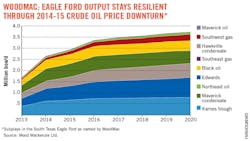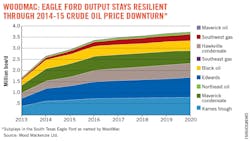Eagle Ford production growth remains resilient because sweet spots continue to emerge across all active subplays despite an activity slowdown caused by low oil and gas prices, said a Wood Mackenzie Ltd. key play analysis.
WoodMac forecast the South Texas play could reach 2 million b/d of oil and condensate in 2020. The forecast was based on $55/bbl oil, and the 2020 output would be lower if prices were to linger more in the range of $40/bbl, analysts noted.
Analysts divided the Eagle Ford into nine subplays, and results showed the South Texas play's core areas remained some of the most attractive oil and gas investment opportunities as of late August.
"Market participants are currently focused on rig count and waiting for production to roll over, but that's not really happening yet," said Jeremy Sherby, WoodMac analyst for the Lower 48 upstream oil and gas. "Companies are still increasing production over 2014 averages, and active rigs are producing more."
Production growth likely will slow in the near term, but the full effect of low oil prices will be moderated as operators retrench to core areas.
Sherby said WoodMac was maintaining its forecast for the Eagle Ford to hit 2 million b/d of oil and condensate production in 2020 although he acknowledged "the path to get there will be different," than it would have been at higher oil prices.
WoodMac said estimated ultimate recovery rates were higher in six of the nine subplays as a result of continued improvements in well performance.
The analysis concluded three core sub-plays (Karnes trough, Edwards condensate, and Black oil) account for about 75% of the play's remaining Net Present Value discounted at 10% (NPV10) and will be the source of much of the near-term growth expected to average 10% in 2015.
"The Eagle Ford has an enviable position as it continues to outperform other shales and remains the focus of Lower 48 tight oil development spend in 2015," Sherby said.
WoodMac finds higher NPV
He listed the following key findings from Wood Mackenzie's analysis:
• Year-on-year total NPV is up $27 billion due to well performance improvements as well as additional derisking of acreage. Specifically in the Karnes trough, WoodMac increased its type well EUR by almost 15% in this core area, which has the lowest breakevens in the Lower 48 at $42/bbl.
• While capex cuts have impacted all plays, the Eagle Ford will attract the most spend of any Lower 48 tight oil play in 2015 at around $20 billion. Over 50% of undrilled liquids volumes for the companies that WoodMac modeled showed a breakeven below $60/bbl.
• Merger and acquisition activity was expected to remain subdued through the end of 2015 as companies focus on Eagle Ford core areas and maintain as much financial flexibility as possible.
• WoodMac expects the number of Eagle Ford wells brought on stream during 2015 will be around 2,700 copared with about 4,000 during 2014.
EIA updates Eagle Ford stats
The Energy Information Administration said crude oil production in September from seven major shale plays is expected to decline 93,000 b/d to 5.27 million b/d.
EIA's estimate came in a September Drilling Productivity Report (DPR). Previously, EIA projected 91,000-b/d declines for both July and August.
The Eagle Ford continues to represent a bulk of the overall oil output declines, projected to fall 56,000 b/d in September to 1.48 million b/d.
The fall marks a dramatic turnaround for an oil industry that had escalated its overall production since 2010.
Currently, operators are running fewer rigs, and an inventory of drilled but uncompleted wells continues to grow.
Earlier this year, EIA said Eagleville oil field in the Eagle Ford was the largest US oil field. Eagleville spans 14 counties.

